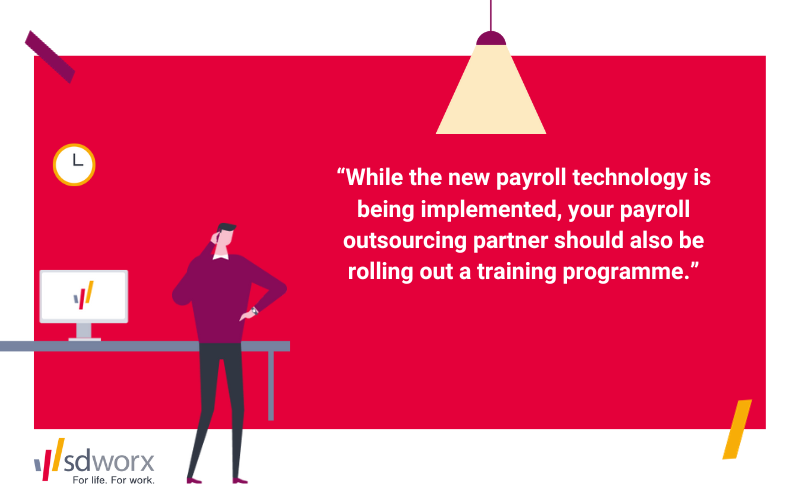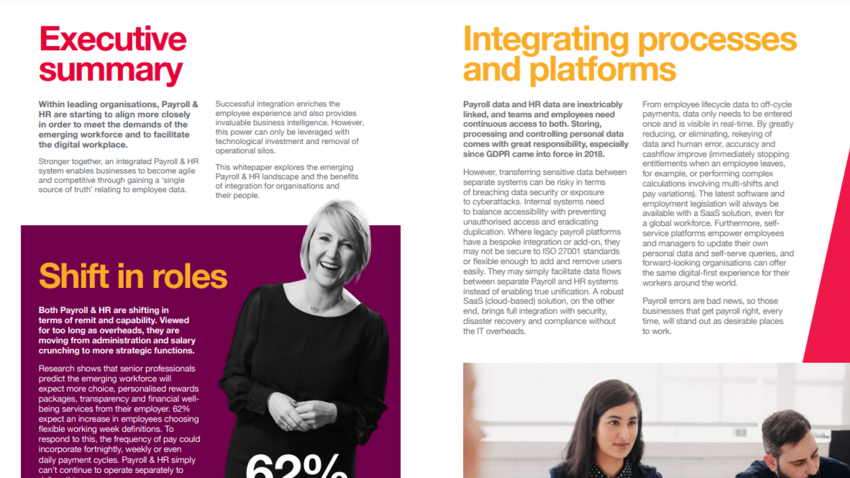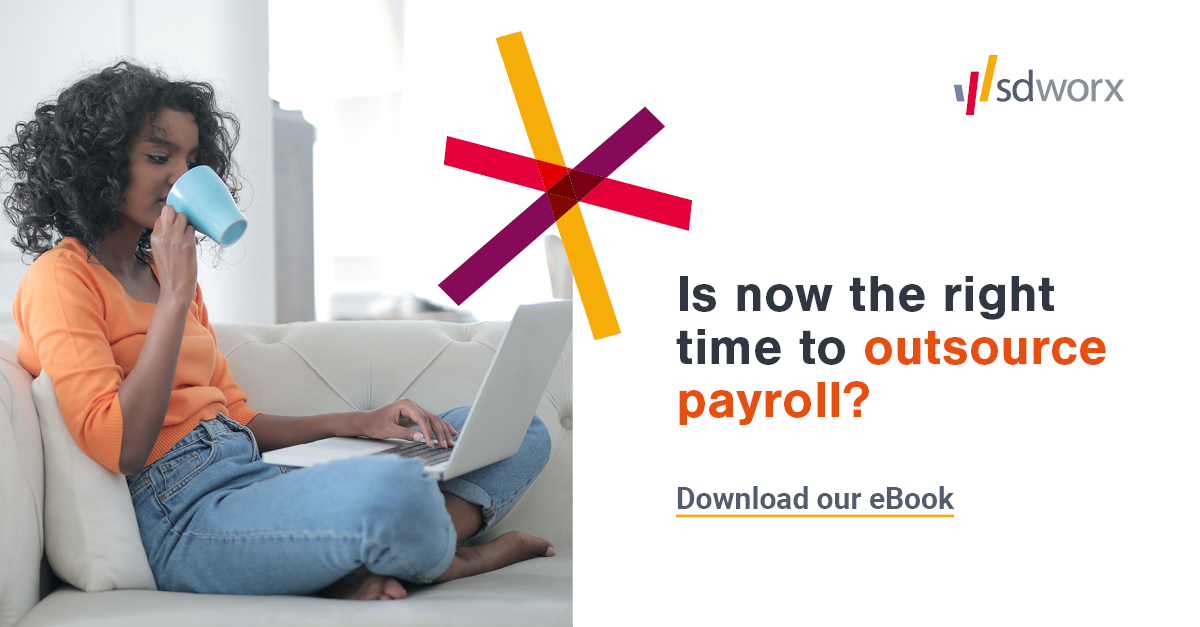Looking for an experienced outsourced payroll partner? Get in touch with SD Worx, industry-leading payroll and HR specialists.

Payroll Outsourcing – Payroll Implementation Process
So, you’ve decided that payroll outsourcing is the right move for your business – amazing! Payroll outsourcing has a ton of benefits. But what can you do to ensure the payroll implementation process runs smoothly?
It’s fair to say that the transition can be a little daunting, without worrying about something going wrong. Before you hand over your payroll responsibilities to an outsourced payroll provider, here’s a quick guide to getting it right.
Any reputable payroll outsourcing provider should be committed to supporting you throughout the entire process. This includes setting up a robust payroll implementation project plan so that you and your team know exactly what to expect at every stage.
It’s not just a case of ‘handing over the keys’ and leaving them to take over. As a payroll or HR professional, you are about to embark on a huge change involving new technology and new processes. Outsourcing your payroll will have a significant (and beneficial!) impact on your business, so communication is key.
While you need to ensure things are managed well at your end, your provider should also be on hand when needed. They should be there to answer any questions and help calm your nerves if you have any concerns. And when it comes to something as important as payroll, no concern is too small.
Payroll Implementation And Your People
For a business transformation project to be successful, it requires all affected parties to be involved in the journey. Don’t just think of the direct impacts of a huge system change either, you need to think in broader terms.
You may have several employees who require access to payroll data to fulfil even the smallest part of their job role. Each of these team members will have a vested interest in the outcome. So, it is crucial that everybody is on the same page, and nobody is overlooked.
To mitigate potential risks, all stakeholders must be involved in the payroll implementation process. If you’re not thorough, you may leave room for data breaches and lost information. For example, if a crucial report was deleted in error, it would subsequently impact the team member who relies on it to do their job.
The Payroll Implementation Process – 5 Simple Steps to Success
Every payroll outsourcing partner will have their own payroll implementation plan and “go-live” process, but all will have some things in common. An experienced provider of outsourced payroll will understand that payroll outsourcing is not a “one-size-fits-all” project.
Whoever you choose to work with, here are five standard stages of the payroll implementation process that you’ll face during the transition. We have also included some tips to help you get the best results as you navigate your way through them.
1. Payroll Outsourcing Launch
During the launch phase of the payroll implementation process, a reputable payroll provider will assign you a personal project manager.
This individual will work closely with you to develop an implementation plan. The first step is to build an in-depth understanding of your current position, including:
- Your internal payroll processes
- Your existing technology
- Any third-party software integrations
- Current licenses and expiration dates
- Any specific issues you’re experiencing
- Any future considerations
It’s important to provide your project manager with as much information as possible. This includes being clear about your expectations - including timescales for implementation.
You should also outline any specific requirements, such as retaining in-house control over certain aspects of your payroll management.
This initial planning phase is also essential to engage the right people to be part of the implementation team. After all, successful projects are built on good relationships and communication.
Your project manager will need to know which of your team members are going to be involved in the implementation. They’ll also want to know which employees may be impacted by the changes as they will need to be kept in the loop.
The payroll implementation team should be carefully selected, both from an internal position and from your payroll outsourcing provider. A good cultural fit and team dynamic will help things run more smoothly. Remember – if things go well, you’ll be working together for a long time.
To create a realistic schedule that suits both parties, you should also consider the availability of those involved. Once the key team has been selected, your project manager will need a good overview of their capacity over the coming weeks so that they can create a timeline for the implementation plan. Make sure that everyone has a copy of the implementation plan once it’s been approved so they can allocate the time required to play their part in line with the activity schedule.

2. Payroll Discovery Stage
This stage of the outsourced payroll implementation process must take place before the new payroll system is put into place. Every business is different. So, to create the right solution and set up for your organisation, the managed payroll provider will need to know key information.
This includes:
- The make-up of your workforce
- How your employees get paid
- When your employees get paid
- Any idiosyncrasies unique to your business model
This is also a good time to ensure that all your employee details/records are up to date. You should also ensure there are no inconsistencies in your pay policies e.g., overtime calculations across different departments/shift patterns.
At this stage, your project manager will also be looking for opportunities to streamline your payroll processes. By developing standardised and automated processes, they’ll be able to create a system that is as efficient and accurate as possible.
Once they’ve created a plan of action, they’ll bring all the project members together to run through their recommendations in terms of the system, its functionality and setup.
This is usually done via a workshop, where everyone has the chance to ask questions and ensure they approve of the plan before moving on to the set-up stage.
Your payroll outsourcing partner will then talk you through the new system. They will detail how it will work and what data they’ll need to be provided with to implement it effectively.
Following this, your team will need to start collating any data required to ensure that your outsourced payroll partner has everything they need to progress.
3. Payroll System Set-Up
The set-up process is a double-pronged approach – getting both systems and people up to speed. A good payroll implementation project plan will have these aspects running concurrently to save time and get things up and running as quickly as possible.
With the payroll system agreed upon, your provider will begin setting up the payroll system according to the plan. This will involve implementing new equipment and payroll software, and integrating any other third-party systems.
Every aspect of your payroll must be considered, including:
- Pay
- Pensions
- Benefits
- Tax and national insurance contributions
- Shift allowances
- Overtime calculations
While the new payroll technology is being implemented, your payroll outsourcing partner should also be rolling out a training programme.
This training will ensure that your employees who need to access payroll information are familiar with the new system. The training process should cover all the essentials, such as:
- A full demonstration of the system
- A chance to try the system firsthand
- An explanation of the system’s functionality and capabilities
- What’s changed from the previous system
- A question-and-answer session to clarify understanding

4. System Testing
The importance of this stage can’t be underestimated – both from an internal and provider point of view. Putting a system live before thoroughly testing it can significantly increase the likelihood of risks.
Once the system has been configured and all involved parties are trained in its use, it needs to be rigorously tested to ensure it’s completely fit-for-purpose.
At this stage, your team will have the opportunity to review the interface from their new position of understanding. Simultaneously, your provider will be able to evaluate user acceptance and iron out any potential problems.
As soon as the system has passed this stage of testing, it’s time to migrate your payroll data from the old to the new.
Once in place, the system can now be further tested and assessed as if it were live (undergoing a specific test called a ‘parallel run’). Your existing payroll system will also be kept active and functioning to prevent interruptions to processes, while also allowing for parallel testing to be conducted.
With both systems accessible, your team and your provider’s team can compare systems and check that the new system is performing as required and expected.
It’s worth bearing in mind that data anomalies often occur at this stage, as the migrated data isn’t live. Thankfully, during this phase, the testing team can identify any inconsistencies and manage them accordingly before the new system is launched in its entirety.
5. Payroll System Goes Live
With the new system in place, your team fully trained, and everything tested, it’s time for the final stage of your payroll implementation plan – to go live.
It is crucial that all relevant parties are made aware that this will be happening. Your payroll outsourcing partner should be encouraging you to communicate the changes business-wide, not just with the employees directly impacted. Payroll impacts every employee in one way or another, so you need to keep everyone informed.
You’ll also need to provide all necessary team members with instructions on the system and their unique login details. This includes any information regarding changes they’ll come across in the new system compared to the previous one.
Remember that the aim is to avoid any hiccups or issues once things are running, so dedicate a little time to providing all the information needed to your team.
As soon as the system goes live, you’ll probably feel a little anxious about your next payroll run – this is completely natural after such a big change within your business. Your provider should be there to offer their help, reassurance, and support during the initial transition.
With this in mind, you should expect a period of ‘hyper care’ from your payroll outsourcing partner, with their team on hand to guide, advise and assure you any time you need it.
Don’t be afraid to ask them anything at all, their job is to ensure that the roll-out goes smoothly and that you have all the information and knowledge you need to relax while they run the show.
The Secret to a Successful Payroll Implementation Plan
While these 5 key steps to successful implementation are the essential backbone of outsourcing to a new payroll service provider, the true secret to an effective roll-out lies within open communication.
Ensuring everyone’s informed at every stage of the journey will help your implementation plan fall into place. Adopting new processes and technology can be challenging, but by keeping your team on board and engaged, you can successfully manage a phased approach where both parties progress at the same speed.
Another secret to successfully implementing a new payroll process is to choose the right payroll software provider for your business…
SD Worx provides award-winning payroll software designed with your people in mind. The secure and flexible software enables you to streamline and simplify your payroll processes whilst enhancing your HR processes, such as onboarding.
Get In Touch With SD Worx
Ready to transform your payroll and HR operations? Get in touch with the SD Worx team to discover what savings you could make by switching to our exceptional outsourced/managed payroll service.


